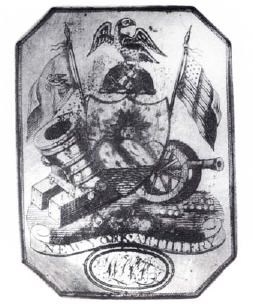
NPS Photo The Trophèe ďArmes that sits atop the sally port of Fort Jay is one of the most distinctive features of the fortification, and the earliest domestically carved military sculpture in the nation. Carved in the 1790s from red sandstone, the statue is rich in symbolism, with a large number of objects arrayed around the central, one-winged eagle: three flags and a bundle of sticks jut out upwards behind the eagle, while a mortar and cannon point outwards to the left and right. Around the work are various types of artillery shot, and the eagle clutches in its talons a shield bearing a dawning sun. Some symbols are common enough: Fort Jay protected New York Harbor throughout the 19th century by way of the artillery mounted behind its walls, explaining the guns and shot present in the sculpture. The flags and the eagle are well-known symbols of the United States of America. More obscure, however, is the bundle of sticks protruding from behind the eagle, topped by a cap. The bundle, called a fasces, was a representation of the early United States, and the cap atop the bundle is a Liberty Cap, a garment worn by the famous Sons of Liberty, a patriotic organization during the American Revolution. 
Michael J. O’Donnell and J. Duncan Campbell The sculpture appears to draw many of its elements from a shoulder plate worn by some New York State artillerymen at the turn of the 19th century. Fort Jay was owned and operated by New York State and its militia, rather than the Federal government in its earliest days, which explains the connection. The shield the eagle holds shows a sun rising over three mountains, still a symbol of New York State that is visible in the state's modern Great Seal. Because of the fragile sandstone used in the work, the sculpture has not always looked precisely as it does today. The earliest known photograph of the sculpture, taken in 1864, shows both of the eagle's wings missing, as well as one of the flags. It is unknown whether these elements fell off between the sculpture's construction and the date of the photograph, or whether they were simply never completed. A photograph taken in 1913 is the first to show the statue after significant work had been done, adding two wings to the eagle and completing the four flags behind it. 
Judy Jacob Today, the National Park Service and its partners have done extensive work to analyze the condition of the Trophee d'Armes, and have considered how best to preserve it. Most recently, in late September, a group of experts assembled at Governors Island National Monument for a two-day charrette, or brainstorming session, to discuss strategies for preservation including possible removal to a building on the island, to protect the sculpture from the elements. It was decided that removal would likely harm the statue further, and that keeping it in place over the sally port, which also needs care, and carefully repairing and restoring both is the best course. This way, the sculpture will remain atop the sally port as it has stood for over 200 years, to be enjoyed by visitors, as the National Park Service and its conservation partners continue their work to preserve this artwork of inestimable value. |
Last updated: April 15, 2016
